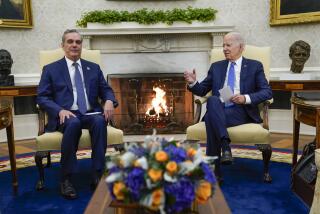Clinton Unveils Sweeping New Export Strategy : Trade: Plan would ease controls on overseas sales of American high-tech equipment. Loan program would link foreign aid to purchase of U.S. goods.
WASHINGTON — President Clinton unveiled a major initiative Wednesday to spur U.S. exports, including a plan to ease outmoded government controls on foreign sales of U.S. computers and other high-tech equipment.
It is a move that Administration officials and business leaders said will finally bring U.S. trade policy out of the shadow of the Cold War.
The Administration export initiative is part of a larger effort by Clinton to make international trade and American competitiveness a top priority of U.S. foreign policy for the first time since World War II. With military and security concerns on the wane following the collapse of the Soviet Union, Clinton is moving to put U.S. economic concerns at the top of his list in international affairs. Export promotion and job creation are central to that effort.
Clinton said Wednesday that the initiative, dubbed the National Export Strategy, is designed in part to respond to complaints he heard about U.S. export policies from business leaders around the nation during his presidential campaign last year.
“Everywhere I went (during the campaign) where there were people who were trying to create the American economy of the future, someone would take me aside and talk about the problems of the export control laws, which may have been needed in a former period when the technology was different and certainly the politics of the Cold War were different, but were clearly undermining our ability to be competitive today,” Clinton said.
The President also went out of his way to note that the relaxation of U.S. export controls on high-tech equipment--which will free about $24 billion worth of U.S. products from licensing requirements--was made easier by the fact that the Pentagon has ended its longstanding resistance to such changes.
During the Ronald Reagan and George Bush administrations, military objections to similar efforts blocked change, with the result that the rules became ever more complex and outdated. The regulations failed to keep up with advancements in computer technology, meaning that more computer products became subject to licensing as computers became more powerful.
“I’d like to thank the people who are involved in our national security efforts who supported these changes, a marked change from times past,” Clinton said.
Other elements of the Administration’s export initiative also attempt to force greater coordination of the federal government’s hodgepodge of trade-related programs. Today, 19 different agencies have some role in helping U.S. firms operating overseas. Now the Administration will pool money that had been split among several agencies into one new $600-million fund to provide low-interest loans to help foreign customers of U.S. firms finance their purchases.
The creation of the loan program marks a controversial attempt by the Administration to tie U.S. foreign aid to purchases of American-made products. In the past, the United States frequently criticized Japan and other countries for doing the same thing, but Commerce Secretary Ronald H. Brown stressed that the Administration is simply trying to “level the playing field” for American firms.
In addition, the Administration said it will set up new regional offices, including one in Los Angeles, to provide one-stop shopping for smaller firms looking for federal help to get into export markets.
“This is just a first step,” Brown said. But he stressed that the initiative should be seen as a sign of an attitude change in Washington. “What we are trying to do is signal clearly that this Administration will work with business.”
More to Read
Inside the business of entertainment
The Wide Shot brings you news, analysis and insights on everything from streaming wars to production — and what it all means for the future.
You may occasionally receive promotional content from the Los Angeles Times.










